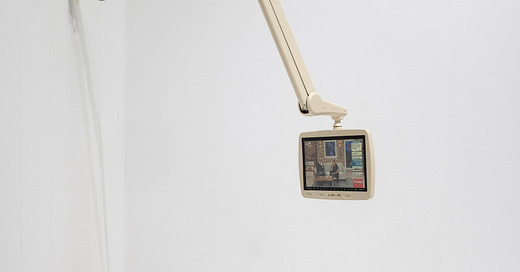Time for a makeover: Presenting the collection at Museum Ludwig
Every two years, the museum dedicated to the art of the 20th century and today switches up its contemporary art collection. Now, it's all about the value of time.
If there is one thing you don’t expect when going to a museum, it’s noise. Going to the lower floor I heard applause. But people were not thanking a guide after a tour, they were standing in front of a work by Robert Rauschenberg (1925-2008, American). Soundings (1968) is an 11-meter-wide lightbox with nine panels and eight microphones dangling from the ceiling.
The new presentation selects works by 31 contemporary artists: Sculpture, film, painting, conceptual, you name it. Texts spread throughout the exhibition offering perspectives on the meaning of time ranging from the political to the philosophical. Robert’s “Soundings” comes alive only when people are around. The work itself needs time and the presence of people.
If you’re standing close enough and make some noise, the boxes light up, revealing X-ray-like images of chairs before turning blank again and leaving you with your golden reflection. It’s fun to see how people stomp, clap, scream, laugh, and run in front of the boxes. It’s like they are applauding a shy performer to come on stage.
Going down memory lane

Other works deal with time as nostalgia. Andreas Schulze (Baby Boomer, German) brings seemingly random objects onto a table as if he’s preparing a garage sale. A sequin cross, a goggly-eyed snake, a lamp, fine china, stuff you can find at your grandparents’ basement. A church tower peaks out behind the bland grey wall of this anonymous suburban backyard. Together, all the corny objects form the painting’s title I ain’t buying anything. German dry humor at its finest.
Traumatic pasts
Time is something people agree on, just like history. Diamond Stingily (Millenial, American) looks at a time that some people consider long gone, while others still feel it in the present. Elephant Memory #27 (2019) is made up of three long chains hanging from the ceiling. The hard cold metal intertwines with three dark braids of soft hair. Every strand looks like a whip. One can strip away a person’s physical freedom and one can take away their identity. Not only were enslaved people chained and flocked, but also they lost their hair, which expressed their belonging. Respectability politics and racist policies still force people to reject their hair, straightening it into normative ideals.

Your request will be handled in 164 business days
Maria Eichhorn (Baby Boomer, German) is the girl who will definitely take her time to bring across her point and she will be merciless with it. She is also the type of artist you commission to create an easy-to-exhibit piece of art that will put you in good lighting and she will do the exact opposite: Employment Contract between the City of Cologne, Represented by the Mayor, and Ms. Maria Eichhorn (2016) is made up of 50 documents from her challenge to become an employee of the city of Cologne: e-Mails, letters, contracts, bank details, blanks, and photographs celebrating the victory. Maria guides through every single dusty corner of the bureaucratic black box and brings the effort of several months into one single glass display.
First, with the development of the mechanical clock, time was separated from human events. Time measurement turned variable hours into constant ones. Which is to say: abstract time. - Moishe Postone
Killing time at the hospital
One of the latest additions to the collection is Extended Stay (2019) by Carolyn Lazard (Millenial, American). A TV mount like those in hospitals is attached to the similarly sterile white wall of the museum. The screen inside endlessly zaps through TV channels and programs, stretching time infinitely if you have nothing to do but lay in bed. For people spending weeks, months, if not their entire life in hospitals, this small screen is their only window to the world far beyond the clinic. Carolyn’s art makes you aware of how different life is for a person living with disabilities compared to an able-bodied one. Actually, disability is quite probable, considering “[a]lmost everyone will temporarily or permanently experience disability at some point in their life” according to the WHO.
History repeats itself

Red blinds hover at various positions underneath a high ceiling. Moving spotlights seem to search for something, casting shadows and glowy shapes on the blinds and walls. The orbs of light look like the sun peeking through the curtains in the early morning or a moon shining through in the night. Haegue Yang (Gen X, Korean) based Mountains of Encounter (2008) on a historical event during the Korean Independence movement. In 1935, the Korean independence fighter Kim San (1905-1937) and the American journalist Nym Wales (1907-1997) met in the Chinese mountain region Ya’an. The moving lights suggest danger, the possibility of getting caught in enemy territory while the blinds offer the only place to hide. But is there safety behind bright red, translucent curtains?
Take your time. You can see On The Value Of Time. New Presentation of the Contemporary Art Collection until August 31, 2025 at Museum Ludwig Cologne.
Museum Ludwig
Heinrich-Böll-Platz
50667 Köln CG
Open every day except for Monday
Admission varying
https://www.museum-ludwig.de/
Thank you for reading this review! Please let me know whether you liked it by writing a comment, liking this post, or sharing it with a friend. But don’t worry: You’ve got all the time in the world :)
See you soon!!!
Jennifer
The Gen Z Art Critic






